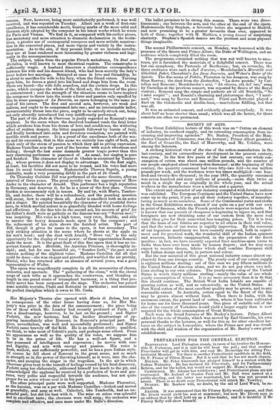SOCIETY OF ARTS.
The Great Exhibition lecture of this week was on" Cotton an element of industry, its confined supply, and its extending consumption from in- creasing and improving agencies." Mr. Barley, President of the Man- chester Chamber of Commerce, was the lecturer ; Prince Albert presided; the Earl of Granville, the Earl of Harrowby, and Mr. Cobden, were among the Reimers.
A striking historical view of the rise of the cotton-manufacture in the last century, and its extraordinary development in the present century, was given. In the first five years of the last century, our whole con- sumption of cotton was about one million pounds, and the number of our people employed about twenty-five thousand ; at the beginning of this century, the quantity consumed had risen fifty-two fold—to one million pounds per week, and the workmen were ten times multiplied—one hun- dred and twenty-five thousand; in the year 1851, the quantity consumed was seven hundred alid sixty millions of pounds,—more than twice as much in a single day as originally in the whole year, and the actual workers in the manufacture were a million and a quarter.
The extent and character of our industry compared with foreign nations was exhibited. The European Continent and the United States have now come up to the point, if you put all their industry together, of manufac- turing as much as we ourselves. Some of the Continental yarns and cloths in the Great Exhibition were almost if not quite on a par with our own in point of fineness, while the French products were superior in taste. It is known that our pursuit of cheapness is beginning to injure us, and that foreigners are now obtaining some of our custom from the more real value they Live for their somewhat less tempting prices. Yet it is true that the mass of our fabrics are superior to all others in their reel value, and that the taste of our wares is rapidly improving. By the resources of our ingenious machinery we have recently surpassed, both in experi- ment and for practical work, the wonderful grill of the Indian spinners and weavers, hitherto unapproached, in the preparation of the finest muslins : in fact, we have recently exported finer machine-spun yarns to India than have ever been made by human fingers ; and we may soon expect to receive thence fabrics which shall combine European skill with Indian design and taste, in pattern and colour.
But the raw material of this great national industry comes almost ex- clusively from one foreign country. The yearly cost of our cotton supply is eighteen millions sterling : out of this sum we pay fifteen millions tee the United States of America alone, and we do not pay above two mil- lions sterling to our own colonies. The yearly cotton crop of the United States is worth thirty millions sterling—nearly the value of our whole yearly consumption of wheat. It is no more necessary than it is fit that this should continue. The British West India Islands are capable of growing cotton as well, and as extensively, as the United States. At Port Natal cotton of the most excellent quality may be grown, and to any reasonable extent. In Australia, cotton equal to the finest of the fine may be grown almost without limit Then there is India, with its enormous extent, the parent land of cotton, where it has been cultivated for home use for three thousand years. One piece of suitable soil of the size of the county of Yorkshire would yield a larger supply than is now required for the whole consumption of Great Britain.
Such were the broad features of Mr. Barley's lecture. Prince Albert added to the vote of thanks, which was moved by Earl Granville, his own personal thanks to the lecturer, as well for this as for other excellent lec- tures on the subject in Lancashire, where the Prince saw and was struck with the skill and wisdom of the organization of Mr. Bazley's own great establishment.


























 Previous page
Previous page